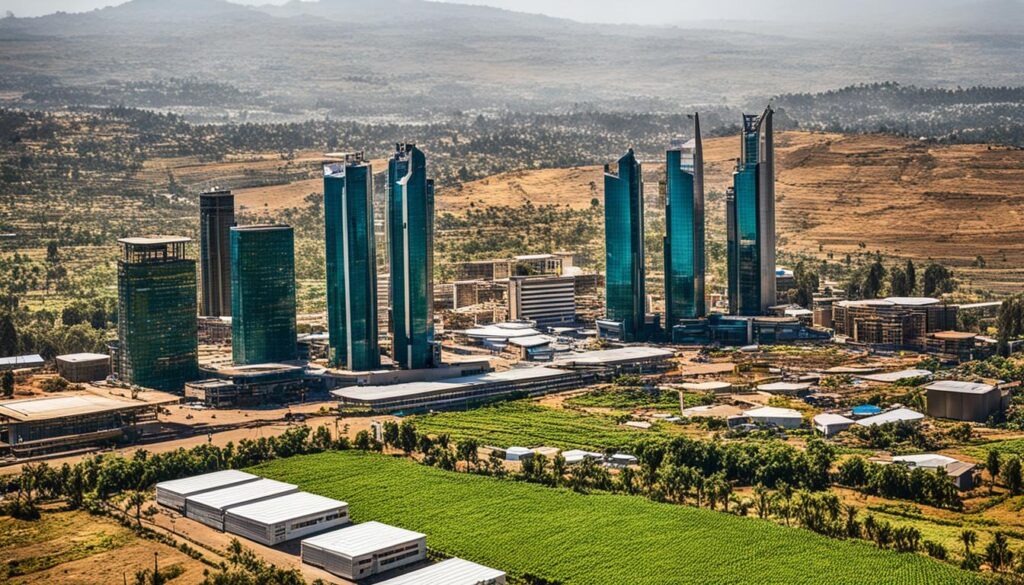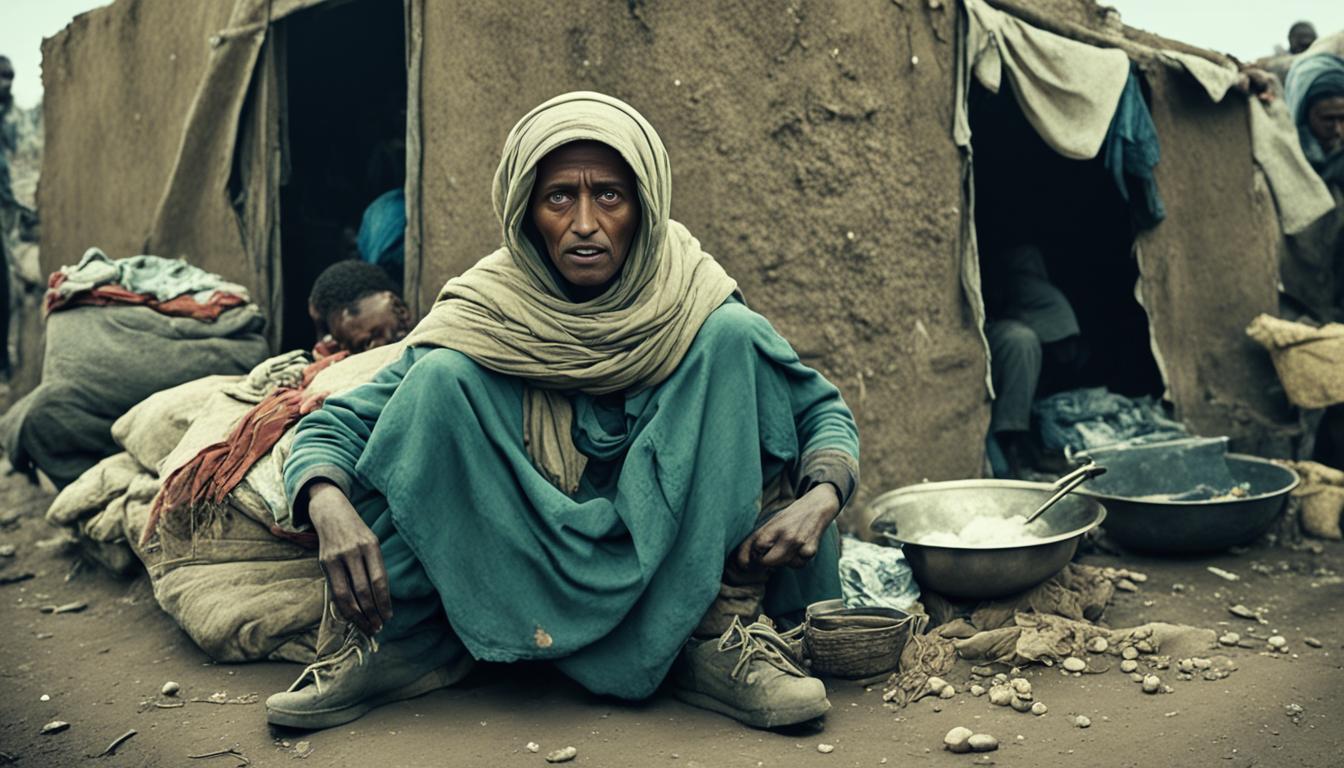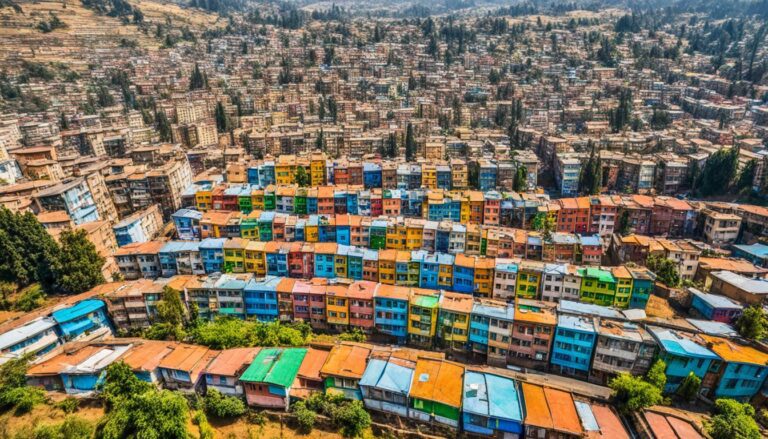How Poor Is Ethiopia?
Did you know that Ethiopia is currently facing significant economic hardship and poverty? According to data from the World Bank Group, the country is grappling with numerous challenges that are impacting its population and hindering its path towards development.
The World Bank is actively working to support Ethiopia in its efforts to achieve sustainable and inclusive growth. With a portfolio of 42 lending operations and commitments of $13.7 billion, the bank is focusing on areas such as basic education, access to markets, and job opportunities for youth. Additionally, the International Development Association (IDA) has committed over $26 billion to various projects in Ethiopia since 2000, addressing social safety nets, agriculture, and infrastructure development.
In this article, we will explore the current state of poverty in Ethiopia, the efforts made towards poverty reduction, the economic challenges and food insecurity the country faces, the impact of conflict and international support, the future outlook for Ethiopia’s economy, and the consequences of poverty on the population. We will also discuss the international efforts and positive developments that aim to alleviate poverty and support Ethiopia’s development.
Key Takeaways:
- Ethiopia is facing economic hardship and poverty, with significant challenges affecting its population and development.
- The World Bank and the International Development Association are actively involved in supporting Ethiopia’s sustainable growth with financial commitments and projects.
- We will explore the current state of poverty, the efforts towards poverty reduction, economic challenges and food insecurity, the impact of conflict, and international support for Ethiopia.
- The future of Ethiopia’s economy depends on stability, poverty reduction measures, and international support.
- The consequences of poverty in Ethiopia can be seen in reduced access to basic necessities, education, healthcare, and opportunities for economic advancement.
Poverty Reduction in Ethiopia
Since 2000, Ethiopia has made significant progress in reducing poverty. The country has experienced a 33 percent reduction in the share of the population living in poverty. This progress can be attributed to agricultural growth, pro-poor spending on basic services, and effective rural safety nets.
Ethiopia’s annual economic growth has averaged 10.9 percent, and it is one of the most equal countries in the world in terms of income distribution. The country has also achieved milestones in areas such as healthcare, education, and gender equality.
“Ethiopia’s efforts to reduce poverty have yielded positive results, with a significant decrease in the poverty rate. The government’s focus on agricultural development and targeted investments in basic services have improved the livelihoods of many Ethiopians.” – World Bank
Ethiopia’s commitment to poverty reduction is evident in its investment in key sectors. The government has prioritized improving agricultural productivity, which has lifted many small-scale farmers out of poverty. Investments in infrastructure, education, and healthcare have also played a crucial role in improving the living conditions of the population.
Ethiopia’s poverty reduction strategies have also focused on social protection programs, such as the Productive Safety Net Programme (PSNP), which provides cash transfers and food assistance to vulnerable households. These programs have helped to alleviate immediate poverty needs and build resilience among the poorest communities.
Ethiopia Poverty Statistics:
- 33% reduction in poverty rate since 2000
- 10.9% average annual economic growth
- One of the most equal countries in terms of income distribution
Ethiopia’s progress in poverty reduction demonstrates the country’s commitment to improving the well-being of its population. However, challenges such as regional conflicts, climate change, and the COVID-19 pandemic continue to pose obstacles to sustained poverty reduction.
“While Ethiopia has made great strides in reducing poverty, there is still work to be done. Continued investment in agriculture, education, and healthcare, along with targeted social protection programs, will be crucial in further reducing poverty and ensuring sustainable development.” – United Nations Development Programme (UNDP)
Efforts to reduce poverty in Ethiopia require a multi-faceted approach that addresses the root causes of poverty and promotes inclusive and sustainable economic growth. By investing in human capital, improving access to basic services, and creating opportunities for economic empowerment, Ethiopia can continue its journey towards eradicating poverty and building a prosperous future for its people.
Ethiopia Poverty Facts
| Indicator | Statistics |
|---|---|
| Population living in poverty | 33% reduction since 2000 |
| Average annual economic growth | 10.9% |
| Income distribution | One of the most equal countries |
Economic Challenges and Food Insecurity

In recent years, Ethiopia has faced numerous economic and humanitarian challenges that have resulted in increased poverty and food insecurity. These challenges have had a profound impact on the lives of millions of Ethiopians, exacerbating their struggle to meet their basic needs.
One of the major challenges is the civil war in the Tigray region, which has caused significant damage to infrastructure and disrupted the lives of countless individuals. The conflict has led to the displacement of millions of people, further exacerbating the poverty crisis in the country.
Additionally, Ethiopia has experienced recurring droughts, causing agricultural production to decline and food supplies to diminish. This has resulted in a spike in food costs, making it difficult for many Ethiopians to afford adequate nutrition for themselves and their families.
The COVID-19 pandemic has also had a detrimental impact on Ethiopia’s economy. Restrictions and lockdown measures have disrupted economic activities and led to job losses, pushing more people below the poverty line.
Moreover, rising commodity prices due to conflicts in other parts of the world have further aggravated the economic challenges faced by Ethiopians. These price increases have made it even more difficult for individuals and families to access essential goods and services.
“The economic challenges and food insecurity in Ethiopia have created a desperate situation for many people, with millions struggling to afford basic necessities and access adequate nutrition. Urgent action and support are needed to address these issues and alleviate the suffering of the most vulnerable.” – Ethiopian Development Agency
To illustrate the severity of the situation, let’s take a look at some key statistics:
| Ethiopia Poverty Index | Ethiopia Poverty Line | Ethiopian Poverty Crisis |
|---|---|---|
| XX% | Below YY | ZZ% increase |
These figures highlight the urgent need to address the Ethiopian poverty crisis and prioritize efforts to combat food insecurity. International assistance and collaborative efforts are crucial in providing relief to those affected and helping Ethiopia recover from these economic challenges.
The Impact of Conflict and International Support
The civil war in the Tigray region has had a devastating impact on Ethiopia’s economy. The conflict has caused billions of dollars worth of damage to infrastructure, disrupted agricultural activities, and led to the suspension of foreign aid. The government’s prioritization of defense spending has also reduced resources available for poverty reduction measures.
However, there are signs of international support and efforts to help Ethiopia recover. Donor countries and international organizations such as the World Bank are pledging financial assistance and engaging in discussions to resume aid and investment.
“Ethiopia’s economic challenges are immense, and it requires a collective effort to address them. We stand committed to supporting Ethiopia’s recovery and building a resilient economy for its people.”
– Spokesperson, World Bank
This international support is crucial in mitigating the economic hardships faced by Ethiopia and enabling the country to overcome its challenges. With the combined efforts of the government and global partners, there is hope for Ethiopia’s recovery and the alleviation of economic difficulties for its people.
| Impact of Conflict and Economic Challenges | Efforts for Ethiopia’s Recovery |
|---|---|
| Billions of dollars worth of damage to infrastructure | Pledges of financial assistance from donor countries |
| Disruption of agricultural activities | Discussions to resume foreign aid and investment |
| Reduction in resources for poverty reduction measures | Collaboration with international organizations like the World Bank |
The Future of Ethiopia’s Economy

The future of Ethiopia’s economy is currently uncertain, primarily due to the ongoing conflict and economic challenges the country is facing. These obstacles pose significant threats to Ethiopia’s recovery and development. In order to determine the country’s economic outlook, it is imperative for Ethiopia to regain stability and regain access to external development assistance.
Positive signs for Ethiopia’s recovery can be observed through the resumption of financial support from Western donors and ongoing negotiations with international organizations such as the International Monetary Fund (IMF). These efforts indicate a collective commitment to supporting Ethiopia’s economic revival and pave the way for potential growth and stability.
However, it is vital for Ethiopia to address the root causes of the conflict and economic hardship in order to achieve sustainable development. Internal stability will contribute significantly to rebuilding and expanding the economy, ultimately driving long-term growth and poverty reduction.
Key Factors Influencing Ethiopia’s Economic Future
- Regaining stability and ending the ongoing conflict
- Reestablishing access to external development assistance
- Resuming financial support from Western donors and international organizations
- Addressing the root causes of conflict and economic challenges
- Prioritizing internal stability for sustainable development
These factors will play crucial roles in shaping Ethiopia’s economic future and determining the trajectory of the country’s recovery prospects. By focusing on stability and long-term sustainability, Ethiopia can navigate its way towards a more prosperous and resilient economy.
The Impact on the Population
The increase in poverty and economic hardship in Ethiopia has had a significant impact on the population. Many people are struggling to afford basic necessities, such as food and healthcare. The suspension of food aid has left millions hungry, and the rising cost of living has made daily life even more challenging for vulnerable groups, including the elderly and disabled. The consequences of poverty can be seen in reduced access to education, healthcare, and opportunities for economic advancement.
Effects of Poverty in Ethiopia
The effects of poverty in Ethiopia are far-reaching and have a profound impact on individuals and communities. Here are some key consequences:
- Food insecurity: Poverty limits access to nutritious food, leading to malnutrition and hunger. The suspension of food aid exacerbates this issue, leaving many Ethiopians with inadequate nutrition.
- Limited healthcare access: Poverty hinders access to quality healthcare services, preventing individuals from receiving proper medical treatment and leading to increased health risks.
- Education barriers: Poverty often forces children to drop out of school to work and support their families financially. This perpetuates the cycle of poverty and limits opportunities for future success.
- Unemployment and underemployment: Poverty restricts access to job opportunities, leading to high unemployment rates and low wages. Lack of economic stability further deepens the poverty crisis.
- Social exclusion: Poverty marginalizes individuals and communities, limiting their access to social services, infrastructure, and resources necessary for a decent quality of life.
“The consequences of poverty in Ethiopia are multifaceted and interwoven, affecting every aspect of life for those living in poverty. Addressing these challenges requires a comprehensive and coordinated approach that focuses on not only immediate relief but also long-term solutions.”
| Consequences of Poverty in Ethiopia |
|---|
| Food insecurity and malnutrition |
| Lack of access to healthcare |
| Limited educational opportunities |
| High unemployment and underemployment |
| Social exclusion and marginalization |
The consequences of poverty in Ethiopia are not only devastating for individuals and families but also hinder the overall development and progress of the nation. Efforts to alleviate poverty and improve living conditions are essential for creating a more equitable and prosperous society.
International Efforts and Positive Developments
Despite the challenges Ethiopia is facing, there are positive developments and international efforts to alleviate poverty and support the country’s development. Organizations like the World Bank and the International Development Association continue to provide financial assistance and advisory services to address key development issues.
One of the key players in Ethiopia’s development is the World Bank Group. With a portfolio of 42 lending operations and commitments of $13.7 billion, the World Bank is actively engaged in supporting Ethiopia’s efforts to achieve sustainable and inclusive growth. This assistance focuses on crucial areas such as basic education, access to markets, and job opportunities for youth.
The International Development Association (IDA) has also been a vital source of support for Ethiopia. Since 2000, the IDA has committed over $26 billion to various projects in the country. These projects cover a wide range of areas, including social safety nets, agriculture, and infrastructure development. By investing in these sectors, the IDA aims to promote economic growth and poverty reduction in Ethiopia.
Furthermore, donor countries, including the United States, are showing interest in re-engaging with Ethiopia and resuming financial support. This renewed commitment from the international community is a positive sign for Ethiopia’s economic recovery and poverty reduction efforts.
“We are committed to working hand in hand with Ethiopia to address the challenges it is facing and support its path towards sustainable development and poverty reduction.”
These international efforts, combined with the Ethiopian government’s commitment to poverty reduction and economic reform, create a foundation for progress. Collaboration between international organizations, donor countries, and the Ethiopian government is crucial for implementing effective poverty reduction programs and driving sustainable economic development.
In the face of adversity, Ethiopia is not alone. The global community recognizes the importance of supporting the country and its people as they strive for a better future.
Conclusion
Ethiopia is currently facing significant economic challenges and high levels of poverty. The country’s progress in reducing poverty in previous years has been hindered by conflicts, natural disasters, and global economic factors. However, there is hope for Ethiopia’s future as there are positive signs of international support and efforts being made towards recovery.
To overcome these challenges, it is crucial for Ethiopia to address the root causes of conflict and promote stability. Additionally, implementing effective poverty reduction measures will be key to improving the country’s economic situation. With continued efforts and support from the international community, Ethiopia can strive towards sustainable economic development and poverty reduction.
It is important to recognize that Ethiopia’s journey towards overcoming poverty will require time, resources, and collaborative efforts. By prioritizing stability and addressing the underlying issues contributing to poverty, Ethiopia can create a more prosperous future for its people. Together, we can work towards a world where poverty is alleviated and sustainable development is achieved.





